Today is June 27 and I'm typing from the air conditioned comfort of a bookstore (WiFi in our house is down. Again.), which is the perfect place to update a blog about international voyages because I can sneak over to the travel section and consult the many books there for interesting details about the places we went. I have next to me three weighty tomes that all promise to guide me to the best restaurants, museums, fiestas, traditions, etc. that Spain has to offer. The only problem with this is that as I scan through these guides I find myself uttering, "How did we miss that!? Where was this? Why didn't we go there?! Oh. My. Gosh! I want a do-over! When can I go back?!"
Yes, I'm cheating. Our trip is already two weeks old and not only is the memory a jumble, there are so many things about the places we saw that I didn't know when we were actually there. According to St. Augustine, "the world is a book and those who do not travel read only a page". I wish I had read more pages of the travel guides before we went. Better late than never, I always say.
Our journey abroad began with a 3-hour flight delay. I saw this as an auspicious beginning for I was convinced that if the plane couldn't even get out of the gate on time, then the quota for Potential Things To Go Wrong was fulfilled right off the bat and the rest of the trip would be smooth as Persian silk. Right!? Right! Let's not mention the semi-emergency visit that morning to my doctor due to an ear infection ("I'm boarding a long and arduous flight across the ocean this afternoon - give me meds now!").
After one of the most miserable transatlantic flights of my career (what does one have to do to get a cup of water these days?), we arrived in Barcelona at roughly 11am next day. The pass through customs went smoothly and we collected our bags then the rental vans. That process took a fair amount of time, so we made the best of it by sitting on the floor and watching the stylish Spanish people bustling to and fro.
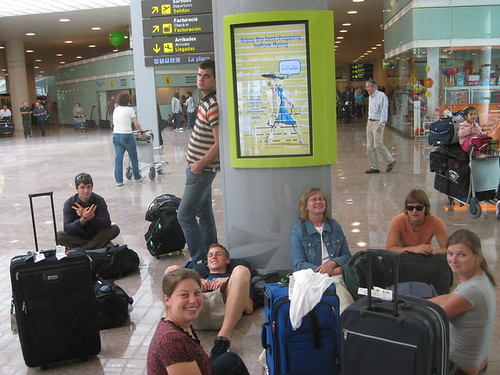 Vehicular transportation secured (a pair of matching mini-vans each named Picasso, which made me wonder why there are no American vehicles named for American artists? Think Ford Pollock or Dodge Wyeth...am I on to something or what?! But I digress...), we were on our way! After a wrong turn out of the airport - a minor thing as all we had to do was find a place to turn around - we were finally aiming toward city center Barcelona. Finding the hotel was a little more of a challenge, even with our GPS navigator and several extraordinarily large fold-out maps (a few words of advice to the self-driving international traveler: Spiral Bound Road Atlas!), but we finally made it. Now, one must keep in mind Europe's long and glorious history - invading Romans, Persians, Turks, Moors, etc. drove horses, not Citroens. When someone wondered out loud why the streets were so narrow my immediate thought was, "Because horses are skinnier than cars".
Vehicular transportation secured (a pair of matching mini-vans each named Picasso, which made me wonder why there are no American vehicles named for American artists? Think Ford Pollock or Dodge Wyeth...am I on to something or what?! But I digress...), we were on our way! After a wrong turn out of the airport - a minor thing as all we had to do was find a place to turn around - we were finally aiming toward city center Barcelona. Finding the hotel was a little more of a challenge, even with our GPS navigator and several extraordinarily large fold-out maps (a few words of advice to the self-driving international traveler: Spiral Bound Road Atlas!), but we finally made it. Now, one must keep in mind Europe's long and glorious history - invading Romans, Persians, Turks, Moors, etc. drove horses, not Citroens. When someone wondered out loud why the streets were so narrow my immediate thought was, "Because horses are skinnier than cars".
This also made the lack of on-street parking in front of the hotel rather an interesting challenge. We contemplated whizzing by several times, chucking a bag out the back onto the sidewalk with each pass but decided against this tactic and just stopped in the middle of the road! Hudson and I ran inside and asked the concierge if he spoke English. "A little", he said, indicating with thumb and index finger just how little. Excellent! Though Hudson spoke no Spanish and I recalled only un poquito, we managed to get through our first encounter just fine.
Cars safely parked and everyone checked in, we met back in the lobby and embarked on our first exploration of Barcelona.
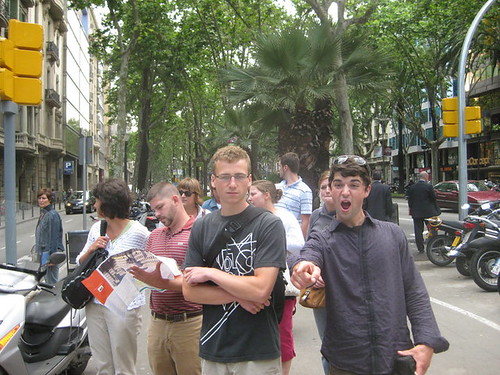
Since we really hadn't eaten since the day before, we immediately enquired as to the location of the nearest cafe. Finding one just down the block, we took over the sidewalk tables and proceeded to enjoy our first meal in Spain. I had a chicken enchilada sort of thing that was out of this world! And the coffee...don't get me started on the coffee!!! It was nectar! Ambrosia! Sweet, creamy deliciousness that I quickly became addicted to. Must. Return. For. Cafe con leche!
Our hotel was situated in the wealthy Eixample area of the city, just north of the Old Town. For the next three days we would call this home base and became very familiar with the nearest Metro station, on Avenguda Diagonal (pronounced dee-a-goo-nal).
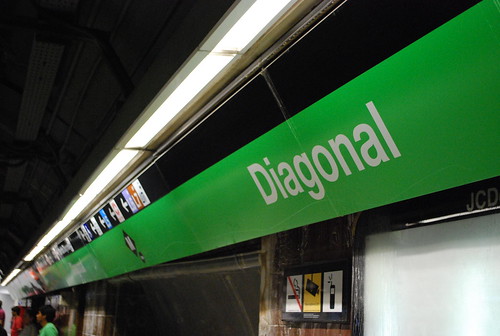
The Metro system and map in Spain is comfortingly similar to that in London, so it took no time at all for me to figure out where we were, where we wanted to go, and which line we needed to take to get there. I especially liked the little lights that glowed as the trains arrived at each stop, so all you had to do was glance up at the map above the doors and you knew exactly where you'd been.
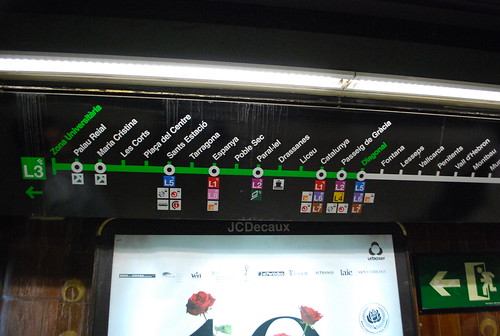
Waiting for the next train.

Emerging from the Metro, we rambled down Las Ramblas, a bustling pedestrian avenue complete with shops, painted street performers, and purveyors of wild animals.



We kept wondering what one did with one's purchase if one were to continue rambling and had to discourage Nate from the temptation to stow reptiles in his cargo pockets.
Just off the Ramblas is the famed and festive La Bouqueria Market. Looking like a detonated box of confetti, the market was a comestible carnival of candies, nuts, chocolates, meats, and
bebidas de frutas. 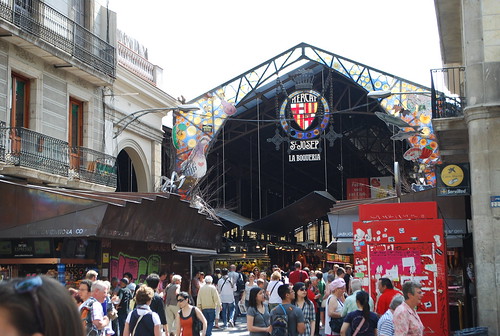

Even though we were there during siesta, many stalls were open. The arrangements of fresh fruit, meat, coffee, spices, and sweets were dazzling.
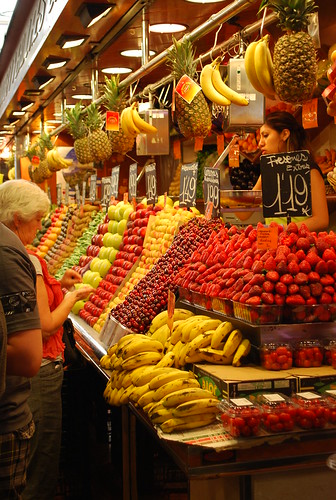
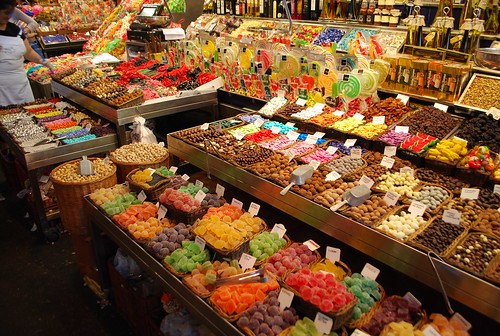
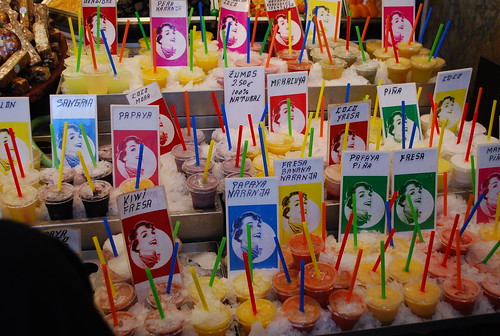

After satisfying our sweet tooths, our next stop was Parque de la Ciutadella, so named for the much despised 18th century citadel that was once located here along with its equally despised militia. The citadel was knocked down and the Triumphal Arch built to celebrate it's destruction. It's the largest, greenest park in Barcelona and houses the museum of geology and a zoo. There's a boating lake (we didn't boat) and Antonio Gaudi, then a student, helped design the central fountain and ornate street lamps.
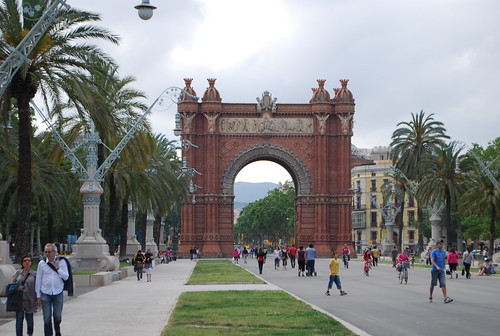
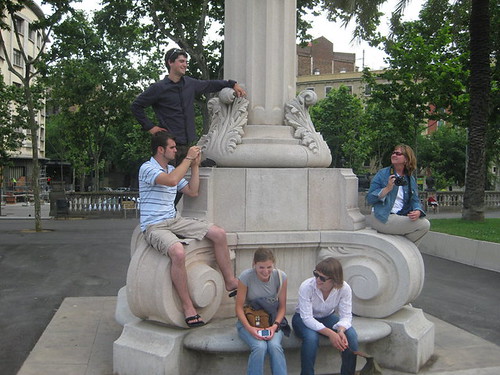
Enjoying Gaudi's designs.

When the citadel was razed, one of the buildings to survive was the Governor's Palace, now a school. The gardens fronting the building were charming but the absence of water in the central fountain was a disappointment.
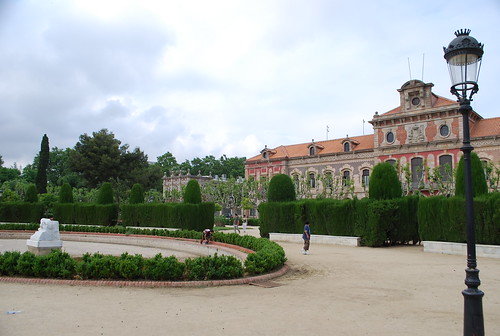
In front of the gardens there was an allee of pleached (or pollarded?) Platanus. Not the usual plant for pollarding, but the effect was pleasing (say that five times fast).
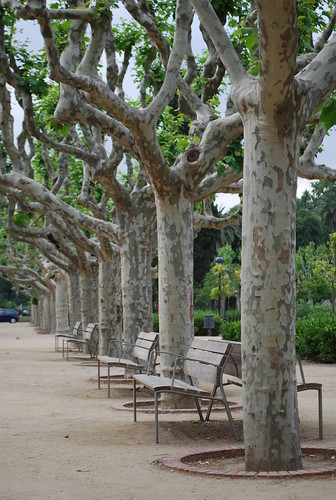
Anyway, Nate really liked them!
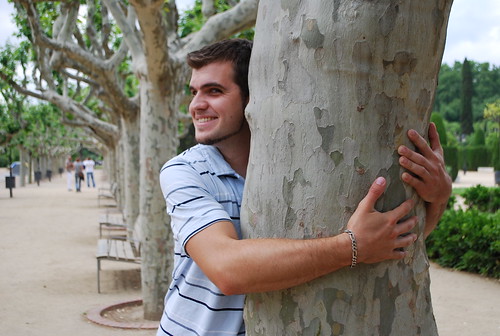
The Shade House was designed by Josep Fontsere and built by Josep Amargos in 1883 when the park was overhauled for a World's Fair exhibition. Constructed of brick, wood and iron, it houses a collection of tropical plants.
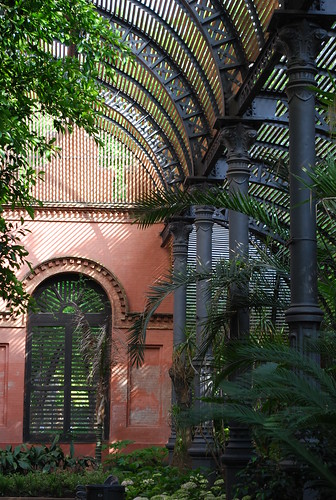
While most of the beds were extraordinarily well-tended, my intrepid plant-loving classmates couldn't help but notice the chlorotic nature of this Hydrangea and tried to diagnose the cause of the malady.

After a stroll through the park, we decided to head toward our next destination, Montjuic. Our chaperons point the way...

...while some of us were already suffering from the physical demands of walking.
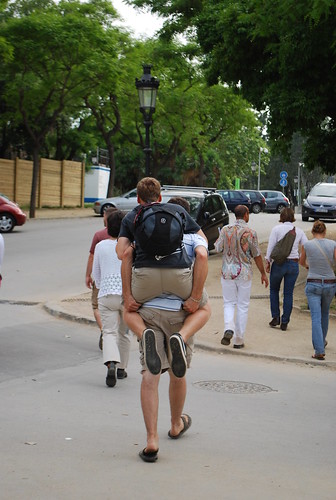
A short hop on the Metro took us to Monjuic - Jewish Mountain - home of the Plaça de Carlos Buigas - a Catalan art museum - and the Estadi Olimpic - built for the 1992 Olympics - as well as numerous gardens including the Jardi Botanic de Barcelona, which we were scheduled to visit next day. The rising avenue from the Plaça d'Espanya up to the Plaça de Carlos Buigas is lined with fountains and a bazillion stairs.

The fountains offer an elaborate show in the evenings but the water isn't on during the day. Still, the view of Barcelona was impressive and we were absolutely dwarfed by the fountain basins.


It was the end of a very long day(s) and we would return another night to see the fountain show so we decided to return to our home neighborhood and search for sustenance. We dined in style, toasting our safe arrival with Sangria at a restaurant called Miguelitos that I highly recommend (beware the bones in the paella). Sated and sleepy, our first day in Barcelona came to a happy end.
Next day: Park Guell and The Barcelona Botanic Garden

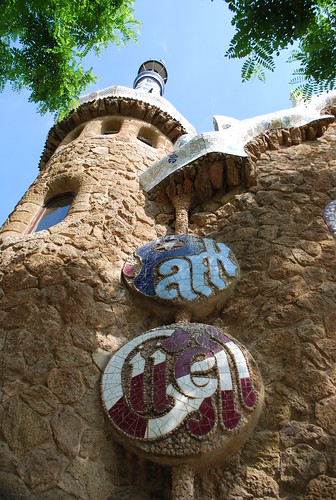
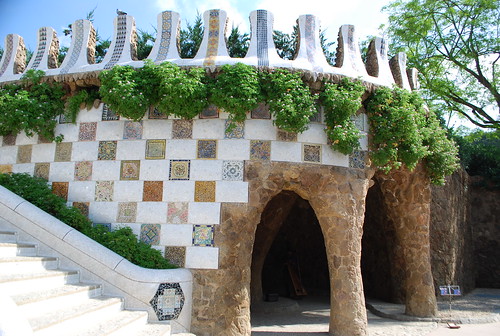


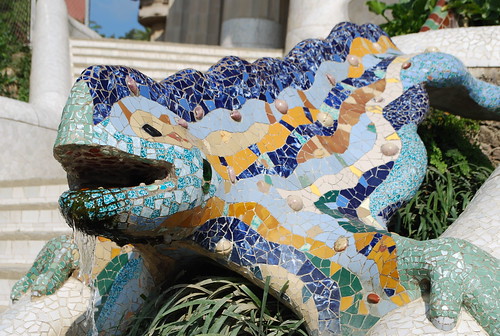
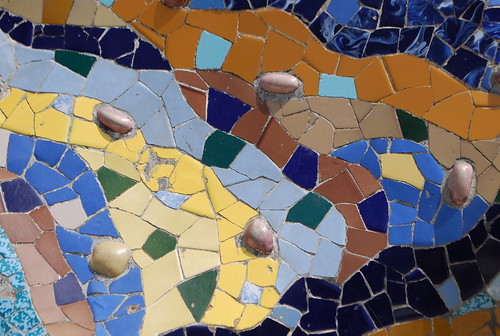
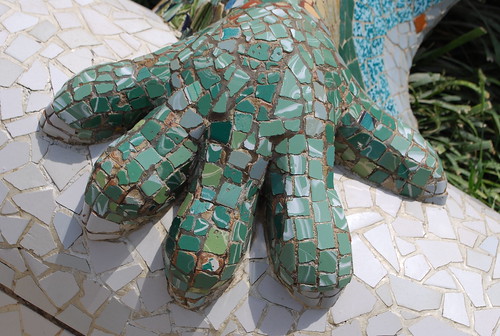 At the top of the steps is the Hall of a Hundred Columns which rise like a concrete forest to support the Gran Plaça Circular - the main terrace - above. After the hot climb up that hill, the Hall provided a cool and welcome respite. Musicians played throughout the park, and the acoustics in the Hall were so good that you could hear the guitar player just as well standing behind him as you could standing in front of him. My buddy Nate and I enjoyed the music sitting on the rear stairs, resting in the cool shade, soaking in the sights and sounds.
At the top of the steps is the Hall of a Hundred Columns which rise like a concrete forest to support the Gran Plaça Circular - the main terrace - above. After the hot climb up that hill, the Hall provided a cool and welcome respite. Musicians played throughout the park, and the acoustics in the Hall were so good that you could hear the guitar player just as well standing behind him as you could standing in front of him. My buddy Nate and I enjoyed the music sitting on the rear stairs, resting in the cool shade, soaking in the sights and sounds. 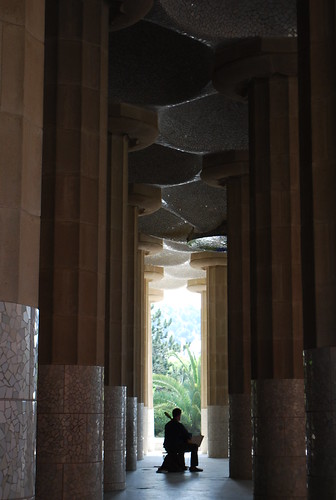 The ceiling of the Hall reminded me of an inverted egg carton with colorful mosaic medallions. It was an appropriate comparison, as the Hall was originally intended to be the housing community's central market, where the sellers and their wares would be protected from the elements.
The ceiling of the Hall reminded me of an inverted egg carton with colorful mosaic medallions. It was an appropriate comparison, as the Hall was originally intended to be the housing community's central market, where the sellers and their wares would be protected from the elements.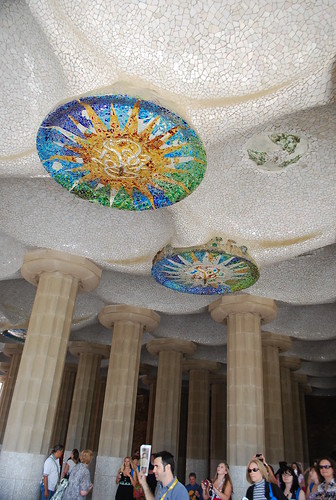
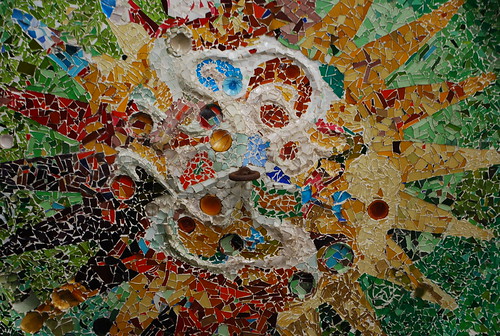
 Gaudí 's training as a blacksmith translated into intricate designs in metalwork.
Gaudí 's training as a blacksmith translated into intricate designs in metalwork.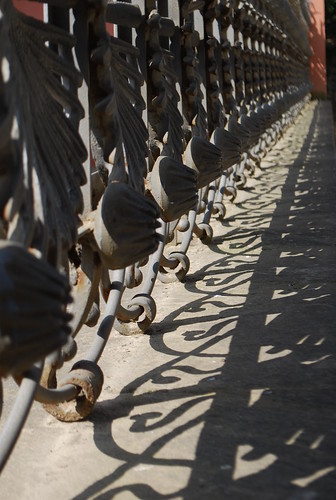 A winding stone staircase leads to the main plaza above the Hall. The wall is studded with these yawning lion's heads, part of the ingenious water catchment system that Gaudí designed. Originally, rain that hit the main terrace was directed to and through the stone columns below where it would feed and power the fountains. Given that the average annual rainfall in Barcelona is only about 23 inches, I don't think the fountains would have been terribly lively.
A winding stone staircase leads to the main plaza above the Hall. The wall is studded with these yawning lion's heads, part of the ingenious water catchment system that Gaudí designed. Originally, rain that hit the main terrace was directed to and through the stone columns below where it would feed and power the fountains. Given that the average annual rainfall in Barcelona is only about 23 inches, I don't think the fountains would have been terribly lively. Directly above the Hall is the Gran Plaça Circular. The view of Barcelona from here is stunning (the slight haze of smog along with the Agaves, Bougainvillea, and Cypress trees felt oddly familiar!). Encircling the plaza like a ceramic beaded necklace is a serpentine bench reputed to be the longest bench in the world. The curves in the bench create cozy alcoves. Supposedly when Gaudí was designing the bench seats he created a mold by parking a worker and his naked buttocks on a block of wet clay.
Directly above the Hall is the Gran Plaça Circular. The view of Barcelona from here is stunning (the slight haze of smog along with the Agaves, Bougainvillea, and Cypress trees felt oddly familiar!). Encircling the plaza like a ceramic beaded necklace is a serpentine bench reputed to be the longest bench in the world. The curves in the bench create cozy alcoves. Supposedly when Gaudí was designing the bench seats he created a mold by parking a worker and his naked buttocks on a block of wet clay.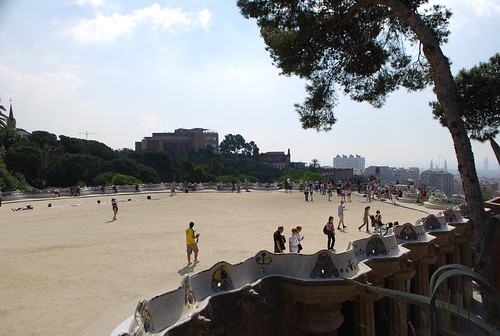
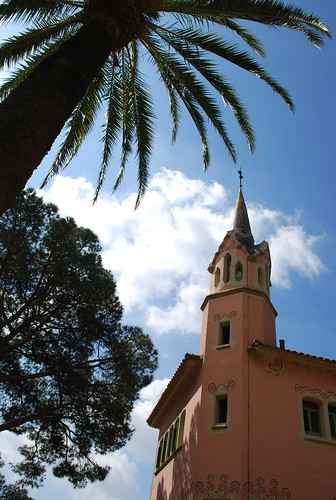
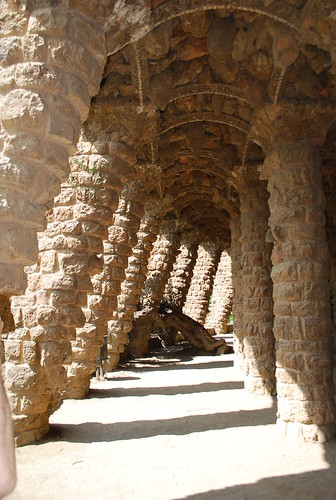
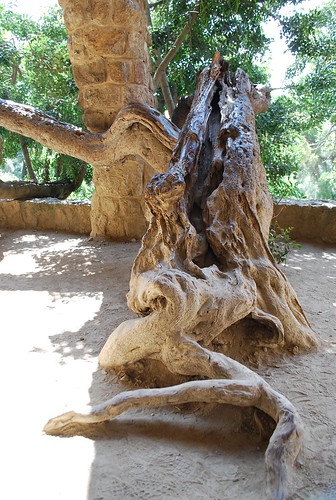
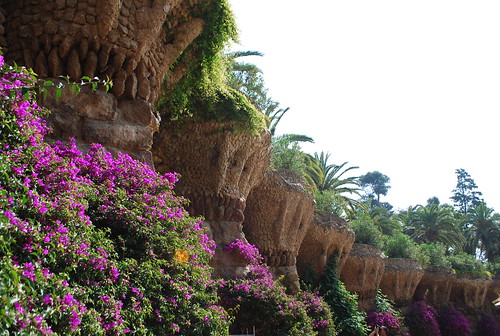 For an even better view of Barcelona, trek up the hill to las tres cruces. There is no guard rail on the narrow stair, so hug the center as you ascend, and especially when descending! From the top, you and 30 of your newest friends will have a 360-degree panoramic view of the city.
For an even better view of Barcelona, trek up the hill to las tres cruces. There is no guard rail on the narrow stair, so hug the center as you ascend, and especially when descending! From the top, you and 30 of your newest friends will have a 360-degree panoramic view of the city.

 Park Güell is one place I will definitely return to, hopefully with much more time to wander and even more time to linger. If you're Barcelona bound, this is one place you just have to see for yourself! Go early to beat the crowds, gas up with a bottle of cold, bubbly agua and enjoy a taste of local life. Stay tuned for another post on Gaudí's unfinished master work, La Sagrada Familia.
Park Güell is one place I will definitely return to, hopefully with much more time to wander and even more time to linger. If you're Barcelona bound, this is one place you just have to see for yourself! Go early to beat the crowds, gas up with a bottle of cold, bubbly agua and enjoy a taste of local life. Stay tuned for another post on Gaudí's unfinished master work, La Sagrada Familia.



 The Metro system and map in Spain is comfortingly similar to that in London, so it took no time at all for me to figure out where we were, where we wanted to go, and which line we needed to take to get there. I especially liked the little lights that glowed as the trains arrived at each stop, so all you had to do was glance up at the map above the doors and you knew exactly where you'd been.
The Metro system and map in Spain is comfortingly similar to that in London, so it took no time at all for me to figure out where we were, where we wanted to go, and which line we needed to take to get there. I especially liked the little lights that glowed as the trains arrived at each stop, so all you had to do was glance up at the map above the doors and you knew exactly where you'd been. Waiting for the next train.
Waiting for the next train. Emerging from the Metro, we rambled down Las Ramblas, a bustling pedestrian avenue complete with shops, painted street performers, and purveyors of wild animals.
Emerging from the Metro, we rambled down Las Ramblas, a bustling pedestrian avenue complete with shops, painted street performers, and purveyors of wild animals.

 We kept wondering what one did with one's purchase if one were to continue rambling and had to discourage Nate from the temptation to stow reptiles in his cargo pockets.
We kept wondering what one did with one's purchase if one were to continue rambling and had to discourage Nate from the temptation to stow reptiles in his cargo pockets.
 Even though we were there during siesta, many stalls were open. The arrangements of fresh fruit, meat, coffee, spices, and sweets were dazzling.
Even though we were there during siesta, many stalls were open. The arrangements of fresh fruit, meat, coffee, spices, and sweets were dazzling.


 After satisfying our sweet tooths, our next stop was Parque de la Ciutadella, so named for the much despised 18th century citadel that was once located here along with its equally despised militia. The citadel was knocked down and the Triumphal Arch built to celebrate it's destruction. It's the largest, greenest park in Barcelona and houses the museum of geology and a zoo. There's a boating lake (we didn't boat) and Antonio Gaudi, then a student, helped design the central fountain and ornate street lamps.
After satisfying our sweet tooths, our next stop was Parque de la Ciutadella, so named for the much despised 18th century citadel that was once located here along with its equally despised militia. The citadel was knocked down and the Triumphal Arch built to celebrate it's destruction. It's the largest, greenest park in Barcelona and houses the museum of geology and a zoo. There's a boating lake (we didn't boat) and Antonio Gaudi, then a student, helped design the central fountain and ornate street lamps.
 Enjoying Gaudi's designs.
Enjoying Gaudi's designs. When the citadel was razed, one of the buildings to survive was the Governor's Palace, now a school. The gardens fronting the building were charming but the absence of water in the central fountain was a disappointment.
When the citadel was razed, one of the buildings to survive was the Governor's Palace, now a school. The gardens fronting the building were charming but the absence of water in the central fountain was a disappointment. In front of the gardens there was an allee of pleached (or pollarded?) Platanus. Not the usual plant for pollarding, but the effect was pleasing (say that five times fast).
In front of the gardens there was an allee of pleached (or pollarded?) Platanus. Not the usual plant for pollarding, but the effect was pleasing (say that five times fast). Anyway, Nate really liked them!
Anyway, Nate really liked them! The Shade House was designed by Josep Fontsere and built by Josep Amargos in 1883 when the park was overhauled for a World's Fair exhibition. Constructed of brick, wood and iron, it houses a collection of tropical plants.
The Shade House was designed by Josep Fontsere and built by Josep Amargos in 1883 when the park was overhauled for a World's Fair exhibition. Constructed of brick, wood and iron, it houses a collection of tropical plants. While most of the beds were extraordinarily well-tended, my intrepid plant-loving classmates couldn't help but notice the chlorotic nature of this Hydrangea and tried to diagnose the cause of the malady.
While most of the beds were extraordinarily well-tended, my intrepid plant-loving classmates couldn't help but notice the chlorotic nature of this Hydrangea and tried to diagnose the cause of the malady.







